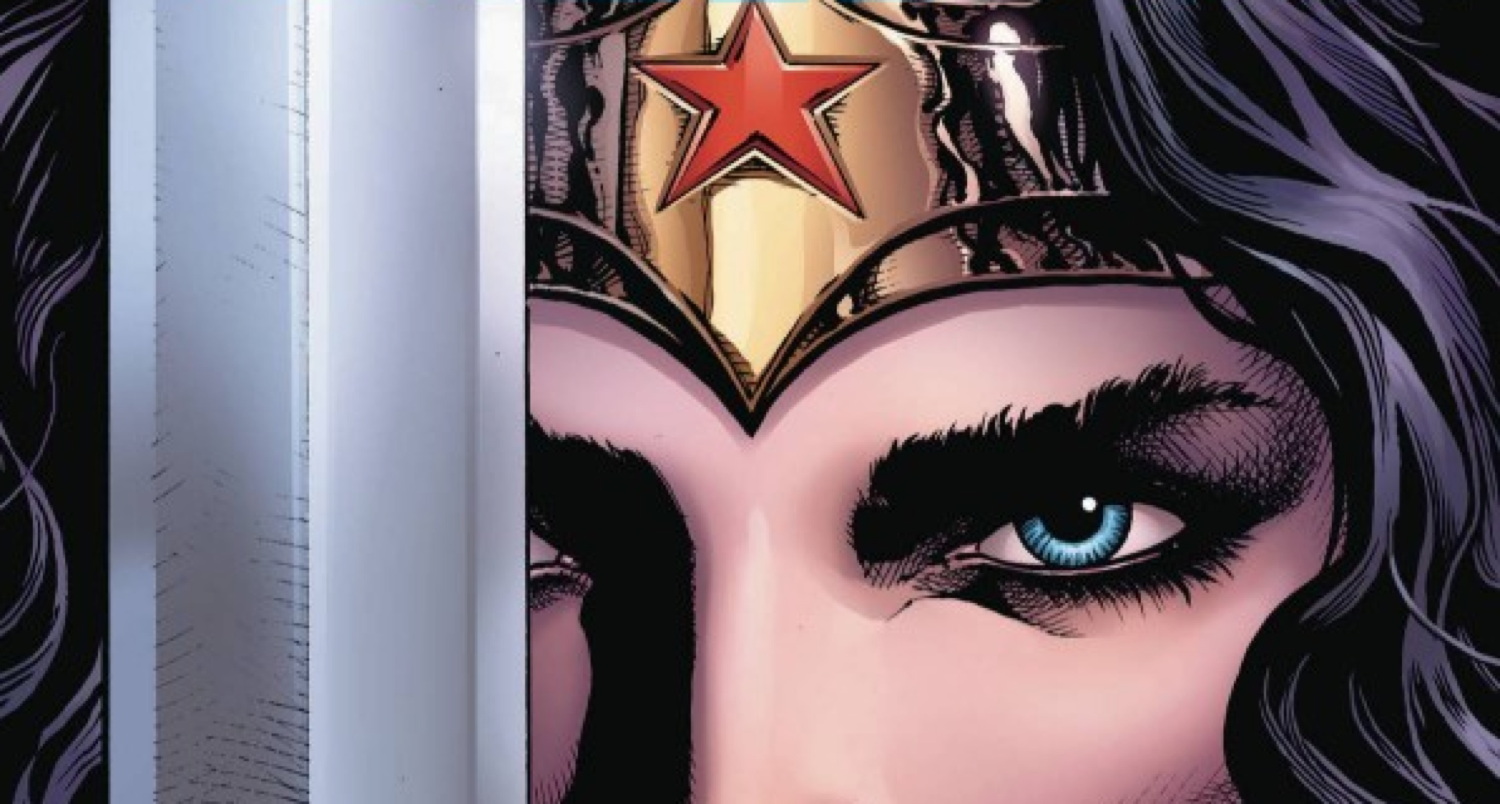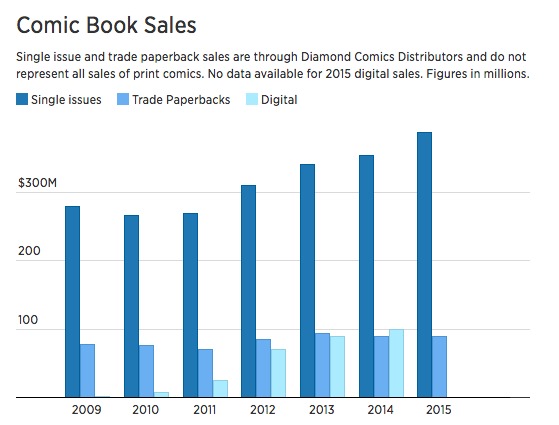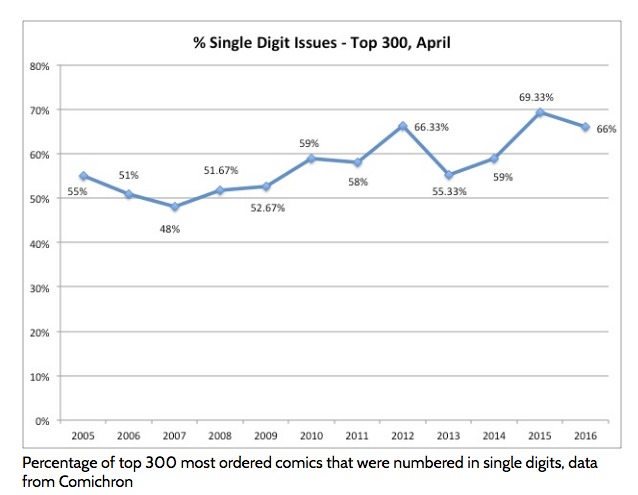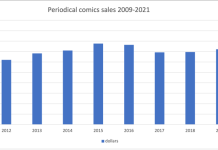If you’re ready to take a breather from the comic book culture wars, a couple of articles this week examined various vital aspects of comic book sales. CBNC pointed out what we’ve been saying here on and on for years, with the succinctly titled Comic books buck trend as print and digital sales flourish, and they even made a little chart.
“We have not seen any cannibalization in sales either in periodical comics or trade paperbacks,” Gerry Gladston, chief marketing officer at New York City–based Midtown Comics, one of the industry’s leading retailers.
Compare that to other print media.
Weekly circulation of newspapers is down 17 percent over the last decade, and advertising sales have plummeted more than 50 percent, according to Pew Research Center. Magazine ad revenue is forecast to see only minimal growth through 2019 on the strength of digital sales after five years of decline, according to PricewaterhouseCoopers.
Comics (and books) have both survived digital disruption. A couple of theories for this are suggested. Midtown’s Gladston falls back on the old “people like to hold a comic” idea, but John Jackson Miller suggests that digital readers and print readers are two separate audiences. Me? A little bit of both. There’s no denying that people like to hold a book and look at it and interact with it in a very different way than they read news, gossip and charticles, but digital is fun and convenient for many people as well.
David Harper is back with a look at Relaunches, Reboots, and Rebirths, including the question of whether we’re going through first issues at a higher rate than ever before. The answer, surprisingly, is no, but he also points out a certain emphasis on the immediate we’ve all been feeling:
These days, the infinite has gotten a lot more finite, or so it feels. Comic books are in an era of reboots, relaunches, rebirths and, most notably, a hearty obsession with recency. No matter what aspect of comics you’re talking about, odds are the conversation is on what’s happening right now above anything else. While that has always been the case to a degree, it has manifested itself in a deluge of first issues and low numbered comics unlike anything we’ve ever seen. While this obsession has coincided with a high time for the industry, it has also led to struggles we haven’t seen before. After all, if the focus is always on the new, how do older comics stay relevant when eyes shift to the next wave?
Harper analyses the number of single digit number issues in the top 300 for several years and finds evidence for the shock of the new. Fewer and fewer comics make it past a single digit run these days.
This chart shows the percentage of the top 300 most ordered comics that were numbered in single digits going back every April to 2005. What we see is an upward trending line save for a couple outliers. Ten years ago, only 51% of April’s top 300 were comics numbered in the single digits; in 2016, 66% of them were. So what does that mean, exactly? These charts show there’s a reason it feels like there’s a greater focus on what’s new, even if the volume of number ones hasn’t increased. It’s because of the companies making the comics that are being launched. In the peak of the number one craze, the bulk were independent or mid-market books. Today, Marvel and DC are leading the way, driven by not quite reboots like Rebirth and whatever exactly the Marvel NOW! redux in the fall entails. In short, the “how many” hasn’t shifted the visibility of this trend as much as the “who” has.
The piece also suggests that the constant news flow of Twitter has an effect on how we approach what’s notable:
Beyond that, focusing on the new keeps the conversation on whoever wields it. Spurrier talked about this in a recent piece hewrote, as the press – which generates a lot of the hoopla in comics – spends more time talking about takeoffs than they do landings, or the flight itself. He’s right. A perfect example of what he was referring to unfolded the week of May 25th. That week, Comic Book Roundup shows that 53 sites wrote reviews for DC Universe Rebirth #1 – an admittedly enormous title – while only six were written for Omega Men #12. That disparity would be understandable if it weren’t for issue #12 being that story’s conclusion. More was written about Omega Men when it wasthought to have been canceled than when it actually ended.
There’s a lot to digest here, and a single viewpoint isn’t really expressed, probably because there is no single viewpoint. Many of the folks quoted in the piece fret about whether ongoing comics serials are even a thing any more, but the Image model seems to be working for a lot of people, at least until they get three or four solid trades on the shelf. Marvel and DC are, of course, engaged in a frantic battle to retain their audiences and grow new ones, and despite what my oldtimer commenters are going to write below, a simple ongoing comic with a few characters we like doesn’t really cut it in the high stakes world of corporate comics.
I’d argue that there are just as many passionately engaged fans of comics as there ever were, if not more. They just approach them through more entry points, whether its graphic novels, webcomics, manga, periodicals or even as media tie-ins. Every conversation I’ve had over the last few weeks with comics folk has been some variation on the “we’re going through a revolution” talk. How we consume all our media is changing so rapidly that it’s hard to predict what will be the winner, or even what will be the concept of a winner.
I do find that the constant race for the new hot take is gliding right over a lot of good comics, especially graphic novels from smaller and more adventurous publishers. There’s a lot of good work being done by committed creators. Periodicals — especially all the relaunching and rebirthing going on — have sucked a lot of the oxygen and attention out of the room. I was told today that getting attention for off beat projects is getting harder almost by the day, and my news feed backs that up.
The attention economy is a tough nut to crack. If you even made it to the end of this article, I’m impressed. I’m still collating all that I’ve learned as I walk this great nation of ours, so more think pieces are coming!











Great insights. Last night on my commute home, the guy in front of me was reading Hellboy via ComiXology , the guy next to me had a JLA HC collection/GN, and I had was reading a digital comic but had a floppy with me too.
As one of the old time commentators, I think you are absolutely right about the sustainability of the old, accepted notion of a comic (especially those outdated attempts to recapture the old X-men or Teen Titans heydays with teams of youthful superheroes)
However, I don’t fret for the medium. As we are seeing with people like Noelle Stephenson, there are markets outside standard comics that seem to be doing just fine.
Instead of dollar amounts, I wish the first chart was physical units. As cover prices have gone up, that will increase dollar amount even if the units shipped is stagnant.
I’m also not surprised that TPB appear to be stagnant. Most Diamond accounts are DM stores. Most DM stores sell singles. Only a small subset of customers will buy a trade if they have the singles, and others will get it if they can’t get back issues. Most TPB prices are no cheaper than buying all the back issues which can often be found on the shelf at my local shop. If I want a TPB, it’s also cheaper to them online from Indigo, Amazon etc instead of paying full cover price (or marked up US as many Canadian shops are doing now) at my local shop. I am also guaranteed to get a new copy and not one that has been thumbed through by customers.
Meanwhile, the Walking Dead has relaunched how many times? Oh right, none.
Imagine that – if you put out consistently good material, sales will remain consistent as well.
Make mine Image.
I think one of the reasons paper comics still sell is because people spend so much time staring a computer screen. They do it for work, they do it with their phones to distract themselves. etc..
At some point you (and your eyes) want a break and physical book is a good way to do it.
I’m kinda happy that we have all these options available now. Gone are the days when it took me forever to track down a few good comics outside DC and Marvel. I can get almost anything now and I freaking love it. I read comics in all formats from webcomics to print, book and on my digital device. It’s truly a renaissance period. Embrace it, enjoy it. Support it, so it can continue to get even better.
Comments are closed.